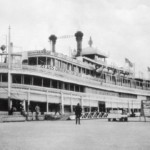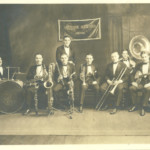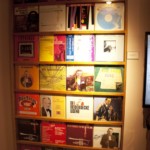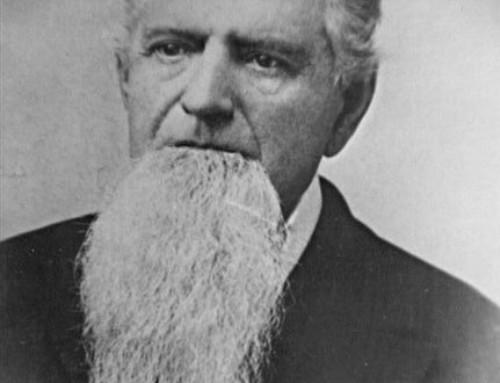Bix Beiderbecke grew into a jazz legend because he was born in the right place at the right time. Sure, he was also a gifted musician, but his path to the top as one of the greatest jazz cornetists was fueled by the inspiration he drew from hearing the earliest jazz musicians play on records and on riverboats.
He was a musical prodigy, which didn’t hurt. The Davenport Daily Democrat published an article in 1910 raving about 7-year-old “Little Bickie’s” ability to play a tune just by listening to it. As a teenager, Bix was captivated by the music of the Original Dixieland Jazz Band, the New Orleans-based outfit that is usually credited with making the first jazz recording (Livery Stable Blues). Bix would fire up the Victrola and listen to the songs over and over until he could play the tunes just like the band did. At first, he copied their tunes on his piano, then with a cornet that he had borrowed from a family friend.
Formal schooling was never a priority for Bix; it’s not a stretch to say that he valued experiences over lectures. When he was failing high school, his parents sent him to a boarding school near Chicago. His academics didn’t improve but his music skills did, thanks to the easy access to speakeasies and their talented musicians. He stayed out late, playing music and drinking, which inevitably led to an early exit from school.
As Bix grew into his late teens, riverboat nostalgia was on the rise. Tin Pan Alley was busy crafting songs that harkened back to those glory days of river travel (and its unquestioned racial hierarchy). John Streckfus, Sr., sensing an opportunity, shifted his Rock Island-based river business from packet boats to excursions that catered to the tastes of a growing white middle class.
By 1920, the excursion business was booming along the Mississippi and Ohio Rivers and the Streckfus family dominated the trade. Day trippers dressed up for a few hours of dining, dancing, and connecting with an imagined river past. Music was a major selling point, and you didn’t even have to be on board to enjoy their music. The river did a fine job of carrying the songs from the boat to the riverfront.
One of the regular stops for the Streckfus steamers was Davenport, Iowa, where young Bix heard music floating across the water and would later answer its siren song. One of those boats provided the setting for the first meeting between Bix and Louis Armstrong, probably in 1920 when Satchmo was playing with Fate Marable’s band on the St. Paul.
It’s not clear how much the two young musicians interacted that first time—Bix would have been 18 years old and Armstrong just 19—but a letter that Armstrong wrote after Bix’s death hints that Armstrong heard Bix play at that early meeting: “Bix was a cute little boy, in his early teens blowing a lot pretty cornet.” Regardless, something clicked between the two. Armstrong wrote that he and Bix “became friends the 1st we met.”
Bix had a much shorter riverboat career than Armstrong, though. He joined the Plantation Jazz Orchestra in June 1921 for a gig on the steamer Majestic. The boat got caught in severe weather and grounded on a sandbar. The captain ordered the band to keep playing, to calm the passengers, so they played Tiger Rag as folks were helped off the boat. No one was hurt, and, after all the passengers had been evacuated, Bix and the band waded to shore carrying their instruments over their heads.
Bix wasn’t allowed to return to the Majestic after union representatives from Davenport Local 67 of the American Federation of Musicians realized Bix didn’t have a union card. To get a union card, a musician had to read music, which Bix couldn’t do and had no interest in learning. Excursion boats only hired musicians approved by the union.
A few days later, Bix got a gig with Doc Wrixon’s band, the Ten Capitol Harmony Syncopators, and set out on a 12-day excursion on the Capitol. Bix was a last-minute replacement, and it is likely that Wrixon didn’t know that the union had cracked down on Bix. When the boat was back in Davenport, the band began playing to attract passengers for an excursion to Muscatine. Union reps boarded the boat and asked to see union cards; when Bix didn’t produce one, he was fired again.
As far as we know, the last time Bix played on the river was the night after he was kicked off the Capitol. The story, perhaps apocryphal, is that Bix enlisted the help of a guy with a small motor boat to meet up with the Capitol near Credit Island as it was returning from that excursion to Muscatine. As the boat pulled aside the steamer, Bix stood up and played his cornet in perfect synchrony with the boat’s band.
Bix, though, would go on to find success far away from the river. He founded a band called the Wolverine Orchestra and made his first record in 1924. They played long improv sets at frat houses and college dances, mostly around Indiana University in Bloomington. He rose to national fame when he started playing with the Jean Goldkette Orchestra in the mid-1920s.
In 1927, Bix and saxophonist Frankie Trumbauer joined the Paul Whiteman Orchestra, then the best-known and best-paying outfit in the country. He had developed a unique style by then, drawing from well-known New Orleans cornetists and contemporary classical composers such as Stravinsky, Dubussy, and Ravel, but forging it into a style that was his alone.
Bix and Louis Armstrong reunited a few years after their riverboat days. In 1928, Bix played a show at the Chicago Theater with Whiteman’s band; Armstrong listened from the balcony. After Bix’s death, Armstrong wrote about that show:
And, oh, he sounded so good…I had to go back stage and say hello to him…And that’s something—I don’t usually do…Bix received me with open arms…Then I told him I [was] playing at the Sunset Café—out on the southside of Chicago…
After Bix was finished with his own show, he went to the southside club. “And stayed there until the customers left,” Armstrong recalled.
That’s when we locked all the doors…My band stayed—Bix and his friends remained…And you talking about a jam session that was priceless!!—Hmm…I’ve never heard such good music since…Bix had a way of expressing himself—his music would want to make you go right up to the bandstand,–shake his hand and make yourself known.
Bix and Armstrong jammed after hours but never recorded together. In the 1920s, bands were segregated and were almost never allowed to record together, but they found ways to hang out and play informally in the back rooms of clubs or in private houses, almost always in African American neighborhoods. (It was far easier for a white man to hang out in a black neighborhood than for a black man to visit a white neighborhood.)
Bix’s life ended far too soon. He was just 28 years old when he died in New York City on August 6, 1931. There is some dispute about what exactly killed him (pneumonia seems most likely), but it’s clear that he was physically worn out from years of heavy drinking and irregular sleep, plus recurring bouts of disabling anxiety and depression.
It’s remarkable how much of an impact Bix had on early jazz, since his solos were usually brief—but they popped, oh did they pop. That’s why he was so widely admired by other musicians. Hoagy Carmichael even named a son after him.
A big part of his legacy is the vast collection of recordings he left behind, more than 250. Many of those records were collaborations with other great musicians of the era, like Bing Crosby. (Bing and Bix even double-dated sisters at one time.)
Bix may only have played professionally for a decade, but his music still resonates and impresses 80 years after his death.
TIP: The Bix Beiderbecke Museum in Davenport is a fine tribute to the hometown hero. It also offers a fascinating peek inside the life of a jazz musician during the Roaring ’20s. Even if you don’t know much about Bix, the historical displays help bring to life an era when jazz was revolutionary (and still rather scandalous), and the musicians who played it were on the front lines of a changing social scene. Check out the article I wrote about the museum in the July/August issue of Big River Magazine.
Looking for other ways to connect with some Bix magic? The Bix Beiderbecke Memorial Jazz Festival features a mix of nationally-known performers and regional musicians. The festival grew from a simple gravesite tribute in 1971, an activity that is still part of the annual event. One more? The Bix 7 Road Race began in 1976 when 84 runners competed; the event has since grown into a big deal that attracts thousands of competitors every year.
Read more about Bix’s home town of Davenport and the Quad Cities in Road Tripping Along the Great River Road, Vol. 1. Click the link above for more. Disclosure: This website may be compensated for linking to other sites or for sales of products we link to.
©Dean Klinkenberg, 2018
Community-supported writing
If you like the content at the Mississippi Valley Traveler, please consider showing your support by making a one-time contribution or by subscribing through Patreon. Book sales don’t fully cover my costs, and I don’t have deep corporate pockets bankrolling my work. I’m a freelance writer bringing you stories about life along the Mississippi River. I need your help to keep this going. Every dollar you contribute makes it possible for me to continue sharing stories about America’s Greatest River!





